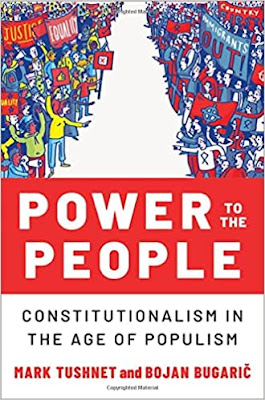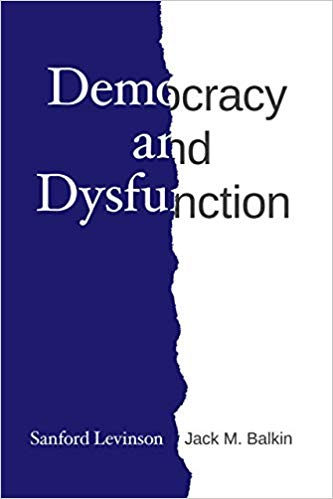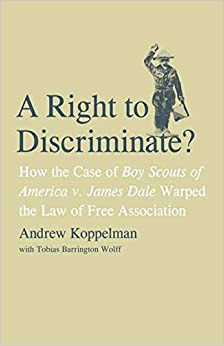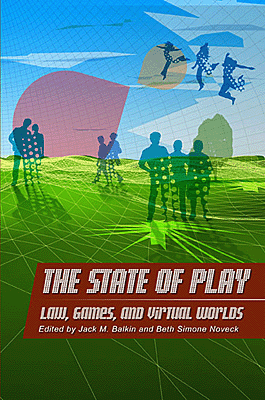Balkinization
an unanticipated consequence of
Jack M. Balkin
Balkinization Symposiums: A Continuing List
E-mail:
Jack Balkin:
jackbalkin at yahoo.com
Bruce Ackerman
bruce.ackerman at yale.edu
Ian Ayres
ian.ayres at yale.edu
Corey Brettschneider
corey_brettschneider at brown.edu
Mary Dudziak
mary.l.dudziak at emory.edu
Joey Fishkin
joey.fishkin at gmail.com
Heather Gerken heather.gerken at yale.edu
Abbe Gluck abbe.gluck at yale.edu
Mark Graber
mgraber at law.umaryland.edu
Stephen Griffin
sgriffin at tulane.edu
Jonathan Hafetz
jonathan.hafetz at shu.edu
Jeremy Kessler
jkessler at law.columbia.edu
Andrew Koppelman
akoppelman at law.northwestern.edu
Marty Lederman
msl46 at law.georgetown.edu
Sanford Levinson
slevinson at law.utexas.edu
David Luban
david.luban at gmail.com
Gerard Magliocca
gmaglioc at iupui.edu
Jason Mazzone
mazzonej at illinois.edu
Linda McClain
lmcclain at bu.edu
John Mikhail
mikhail at law.georgetown.edu
Frank Pasquale
pasquale.frank at gmail.com
Nate Persily
npersily at gmail.com
Michael Stokes Paulsen
michaelstokespaulsen at gmail.com
Deborah Pearlstein
dpearlst at yu.edu
Rick Pildes
rick.pildes at nyu.edu
David Pozen
dpozen at law.columbia.edu
Richard Primus
raprimus at umich.edu
K. Sabeel Rahmansabeel.rahman at brooklaw.edu
Alice Ristroph
alice.ristroph at shu.edu
Neil Siegel
siegel at law.duke.edu
David Super
david.super at law.georgetown.edu
Brian Tamanaha
btamanaha at wulaw.wustl.edu
Nelson Tebbe
nelson.tebbe at brooklaw.edu
Mark Tushnet
mtushnet at law.harvard.edu
Adam Winkler
winkler at ucla.edu
Compendium of posts on Hobby Lobby and related cases
The Anti-Torture Memos: Balkinization Posts on Torture, Interrogation, Detention, War Powers, and OLC
The Anti-Torture Memos (arranged by topic)
Recent Posts
Ruination, Democracy and the Participant Attitude
Just A Few Blogs
ACS Blog
Alas, a Blog
Althouse
Arts and Letters Daily
Atrios (Eschaton)
Bill of Health
Buzzflash.com
Buzz Machine
Cato at Liberty
Juan Cole (Informed Comment)
Concurring Opinions
The Constitution in 2020
Corrente
Crooked Timber
Daily Howler
Daily Kos
Dana Boyd
Brad DeLong
Digby (Hullabaloo)
Discriminations
Daniel Drezner
Kevin Drum (Mother Jones)
Electrolite
En Banc
Eunomia (Daniel Larison)
Fafblog
Michael Froomkin (Discourse.net)
GovLab (Beth Noveck)
Rick Hasen (Election Law)
History News Network
How Appealing
Ignatz (Sam Heldman)
The Importance of (Ernie Miller)
Infolaw
Instapundit
International Economic Law and Policy Blog
IntLawGrrls
Jacob Levy
Jesus' General
Jurisdynamics
The Kitchen Cabinet
Mark Kleiman
Law Blog Central
Larry Lessig
Lawyers, Guns and Money
Liberal Oasis
Brian Leiter's Law School Reports
The Leiter Reports
Marginal Revolution
Megan McArdle
Memeorandum
Metafilter
Mirror of Justice
The New Republic
Newseum
No More Mister Nice Blog
Brendan Nyhan
Opinio Juris
Orcinus
The Originalism Blog
Pandagon
Passport (Foreign Policy)
Overcoming Bias
Political Animal (Washington Monthly)
Political Theory Daily Review
Political Wire (Taegan Goddard)
The Poor Man
Virginia Postrel
Prawfsblawg
Public Reason
Jonathan Rauch
Raw Story
Redstate
ReligiousLeftLaw.com
Reporters Committee For Freedom of the Press
Reproductive Rights Blog
Rothman's Roadmap to the Right of Publicity
SCOTUS Blog
Seeing the Forest
Clay Shirky
The Shifted Librarian
The Situationist
Larry Solum (Legal Theory)
Andrew Sullivan
Talking Points Memo
Talk Left
Tapped
Tbogg
TechPresident
The Paper Chase (Jurist)
Tom Paine
Tom Tomorrow (This Modern World)
Eve Tushnet
Uggabugga
University of Chicago Law School Faculty Blog
Unqualified Offerings
The Volokh Conspiracy
War and Piece (Laura Rozen)
Wampum
Oliver Willis
Wonkette
Written Description
Matthew Yglesias
Yin
Your Choice of Feeds
1. XML
powered by
2. Atom Feed
3. RSS 2.0
Ruination, Democracy and the Participant Attitude
Guest Blogger
For the Balkinization symposium on Judith Resnik, Impermissible Punishments: How Prison Became a Problem for Democracy (University of Chicago Press, 2025). Gideon Yaffe Judith
Resnik’s Impermissible Punishments is a magisterial work. What launches the book is the simple
observation that prison is profoundly embedded in our lives. It’s conditions, rules, principles, enabling
conditions and political circumstances are, themselves, in any given time and
place, highly particular, and they changed and flowed over the many decades
since prison’s invention. The book’s
central aim is to give a detailed account of how it came to pass that prison
became the enormous, deeply entrenched social practice it is, with all of its
distinctive facets. Of course, the
answer to the book’s central question is, “It’s complicated”. And the book is driven by a determination not
to oversimplify; Resnik embraces complexity.
The philosophy of Jeremy Bentham played a role in the state of the
social practice and the institutions that support it. Conferences hosted by relatively minor
historical figures played a role. Medical
doctors and people devoted to the logistics of housing and feeding people
mattered. The moral consciences of
presidents, Supreme Court justices, imprisoned people, not to mention the
family and friends of the imprisoned, played a role. As did the curiosity-driven work of sociologists,
criminologists, economists, philosophers and political scientists. The bulk of the book is descriptive. Resnik does her best to accurately describe
the startling number of interacting forces and figures that produced the
prison-infused world of today. Comprehensiveness is simply not possible in this
domain, perhaps not even in principle; but Resnik tries.
It is probably
hubristic to suggest that the line of thought in the book that most drew my
attention, and on which I will focus here, is a central line of thought
in this work. The book has multiple
centers. Perhaps it is more fitting to
say that I will here focus on a recurrent theme, which both begins and ends the
book, and to which Resnik returns in many places throughout it. This is Resnik’s idea of “ruination”. That a punishment produces ruination is
sufficient for its impermissibility. Or,
put the other way, a punishment is permissible only if it avoids producing the
ruination of the person on whom it is inflicted. As Resnik sees it, the central feature of
contemporary imprisonment that undermines its permissibility is that it
frequently ruins those who suffer it, and tends in that direction even in those
who emerge unruined. So, a first
question is: what does Resnik means by “ruination”? In her
introduction of the concept, and where-ever the concept is invoked in the book,
it is connected, by her, to the idea of a reduction of personhood. To ruin someone is to make them less of a
person. But this idea, too, is
elusive. Every creature on the planet is
either a person or not. Personhood is
binary; it is not something that admits of degrees. What does admit of degrees is the influence
that particular individuals have over decision-making processes—processes that
produce their own decisions, and the decisions made by or affecting groups of
which they are a part. If we give the
title “person” to an individual who gets a full helping of influence, someone
who gets less than a full helping is less of a person thanks to that. Given a set of social arrangements and
circumstances, each individual has some degree of influence over relevant decision-making
processes. We might conceptualize each individual’s
degree of influence over decision-making processes that matter, decision-making
processes concerning acts of moral import, as their degree of personhood. Dogs are not people, then, since they have no
influence over morally relevant decision-making processes. In this sense, children are people, but they
are diminished in personhood, in comparison to adults, in many aspects of
socially-entwined life. They have some
influence, but less influence than adults, over relevant decision-making
processes. A strong
reason to think that Resnik would endorse this way of understanding degrees of
personhood is the link that she sees between ruination and democracy. In its ideal form, democracy is an effort to
evenly distribute a particular “good” across people, and only
people; non-persons get none of it, lesser persons get less. The “good” that is to be evenly distributed
in a democracy is influence over decision-making procedures concerning matters
of social and moral import. In this
sense, then, the way prison became a problem for democracy, to quote the book’s
subtitle, was by becoming a mechanism for reducing or eliminating the influence
over collective decision-making of the millions of individuals subjected to
it. The primary
way in which prison had this effect, under Resnik’s description, was through
producing subjugation of a sort that undermines the very possibility of looking
another in the eye and making a decision together. A necessary condition of effective mechanisms
for joint deliberation is some relatively low baseline of give-and-take among
participants in the group aiming to make joint decisions. Where some in the group dominate, control and
subjugate others, this is lost. So: prison
produces subjugation; subjugation eliminates the influence of the subjugated
over joint decision-making processes; limited influence of this sort is a
diminishment of personhood. Prison, in
short, produces ruination. And with ruination comes the loss of the very
decision-making mechanisms that are essential to democracy. Resnik
believes that none of this is inevitable; it is possible, in principle, for a
democracy to warrant that label and, still, to punish offenders. But she also thinks a democratic state faces
an almost impossibly difficult task. She
writes, “Acceptance of the proposition of equal status makes decisions about
punishment harder because the state itself must fulfill its obligation
of expressing the wrongness of acts of violence, aggression, and exploitation
without violating its parallel obligation to shape a fair and just social
order.” There are famous challenges for
those, like Resnik, drawn to an expressivist theory of the justification of
punishment—a theory according to which what justifies punishing is that it
serves as an expression of shared social values and a public acknowledgement
that the offender’s act was in violation of those values. But in so far as the expressivist holds that
the appropriate response to acts of violence, aggression and exploitation
requires public elevation of the victim and denigration of the offender, or at
least their act, Resnik is right to see a profound challenge here. How can we at once express solidarity with
the victim by declaring the offender’s act to be loathsome and at the same time
grant both parties a full helping of influence over joint deliberative
processes? I think it
helps to see what a solution to this dilemma might look like, in what I hope to
be a Reznikian spirit, by reflecting on something which might be missing, too
often, from our collective attitude towards prisoners. The philosopher Peter Strawson, in his famous
essay “Freedom and Resentment”, uses the term “participant attitude” to refer
to the attitude that one person has towards another when their responses to the
other’s behavior are constitutive of bonds between people out of which are
built the distinctive forms of relationship that human beings can have only
with other human beings. Friendships,
reciprocal relationships of love and respect, even certain kinds of rivalries, consist
of connections between people that are constituted by, built out of, reactions
to one another that the parties have only when they view each other not merely
as sources of danger or pleasure, to be avoided or sought, but as proper
participants in relationships of the relevant sort. Resentment is an attitude that we have
towards the agent of an act when the agent has violated a norm at our
expense. But resentment is to be
distinguished from fear or fury. Fear
pushes one towards avoidance, or even towards changing, we might even say reforming,
the entity that caused us to be afraid.
The person who is scared of the dog that lunges at them might run or
draw back or try to train the dog, or lock it in a cage. But resentment of the dog requires viewing
the dog as a participant in the kind of relationship of mutual accountability
that human beings have sometimes with other human beings. What it is to be in a relationship of mutual
accountability is for each to respond with resentment to acts of the other that
are wrongful and at their expense. We
might think of co-citizenship as such a relationship. The bonds between co-citizens consist in
reactions—what Strawson called “reactive attitudes”—to their behavior when they
are viewed from the participant attitude.
Too often our collective attitude towards prisoners is not the
participant attitude. Too often our
response to crime is not resentment, or the analog of resentment that one
person has when another is wronged by a third, but fear or anger. Too often, that is, we do not respond to
violence, aggression and exploitation in the distinctive way in which one so
responds when viewing the agent of the violent, aggressive or exploitative act
as fit to be a co-citizen. At
one point in the book, Resnik criticizes Justice Warren Burger’s view that the
best, (perhaps the only) path by which prisoners could come to be less badly
treated was to appeal to the moral consciences of those doing the work of
imprisoning people. In Burger’s view, the answer was not to be found in the
law, or in judicial decrees. Resnik, by contrast, believes in the power of law
in this domain and explains how legal pressures were used, often by prisoner’s
themselves, to promote many fundamental and valuable reforms. One
might fear that my diagnosis of the disease—a failure to adopt the Strawsonian
participant attitude towards prisoners—is more Burgerian than Resnikian. If you fear your neighbor rather than resent
them, the problem is not likely to be remedied by being told by some judge to
view them, instead, with the participant attitude. But, it seems to me that the essential
collective moral education that might solve the problem of prisons is also a
kind of legal education. Just as
citizenship is a legal concept, so is co-citizenship. Law, in this domain, plays a role in
constituting a moral relationship that, it seems to me, is absent where we fail
to adopt the participant attitude. In a
sense, the lesson of Resnik’s impressive book is that prison became a problem
for democracy because it became a tool for management, rather than a tool for
the expression of the attitudes that are an essential part of genuine
co-citizenship. Gideon Yaffe is Wesley Newcomb
Hohfeld Professor of Jurisprudence and Professor of Philosophy and Psychology
at Yale Law School. He can be reached at
gideon.yaffe@yale.edu.
Posted
9:30 AM
by Guest Blogger [link]
Books by Balkinization Bloggers

Linda C. McClain and Aziza Ahmed, The Routledge Companion to Gender and COVID-19 (Routledge, 2024)

David Pozen, The Constitution of the War on Drugs (Oxford University Press, 2024)

Jack M. Balkin, Memory and Authority: The Uses of History in Constitutional Interpretation (Yale University Press, 2024)

Mark A. Graber, Punish Treason, Reward Loyalty: The Forgotten Goals of Constitutional Reform after the Civil War (University of Kansas Press, 2023)

Jack M. Balkin, What Roe v. Wade Should Have Said: The Nation's Top Legal Experts Rewrite America's Most Controversial Decision - Revised Edition (NYU Press, 2023)

Andrew Koppelman, Burning Down the House: How Libertarian Philosophy Was Corrupted by Delusion and Greed (St. Martin’s Press, 2022)

Gerard N. Magliocca, Washington's Heir: The Life of Justice Bushrod Washington (Oxford University Press, 2022)

Joseph Fishkin and William E. Forbath, The Anti-Oligarchy Constitution: Reconstructing the Economic Foundations of American Democracy (Harvard University Press, 2022)

Mark Tushnet and Bojan Bugaric, Power to the People: Constitutionalism in the Age of Populism (Oxford University Press 2021).

Mark Philip Bradley and Mary L. Dudziak, eds., Making the Forever War: Marilyn B. Young on the Culture and Politics of American Militarism Culture and Politics in the Cold War and Beyond (University of Massachusetts Press, 2021).

Jack M. Balkin, What Obergefell v. Hodges Should Have Said: The Nation's Top Legal Experts Rewrite America's Same-Sex Marriage Decision (Yale University Press, 2020)

Frank Pasquale, New Laws of Robotics: Defending Human Expertise in the Age of AI (Belknap Press, 2020)

Jack M. Balkin, The Cycles of Constitutional Time (Oxford University Press, 2020)

Mark Tushnet, Taking Back the Constitution: Activist Judges and the Next Age of American Law (Yale University Press 2020).

Andrew Koppelman, Gay Rights vs. Religious Liberty?: The Unnecessary Conflict (Oxford University Press, 2020)

Ezekiel J Emanuel and Abbe R. Gluck, The Trillion Dollar Revolution: How the Affordable Care Act Transformed Politics, Law, and Health Care in America (PublicAffairs, 2020)

Linda C. McClain, Who's the Bigot?: Learning from Conflicts over Marriage and Civil Rights Law (Oxford University Press, 2020)

Sanford Levinson and Jack M. Balkin, Democracy and Dysfunction (University of Chicago Press, 2019)

Sanford Levinson, Written in Stone: Public Monuments in Changing Societies (Duke University Press 2018)

Mark A. Graber, Sanford Levinson, and Mark Tushnet, eds., Constitutional Democracy in Crisis? (Oxford University Press 2018)

Gerard Magliocca, The Heart of the Constitution: How the Bill of Rights became the Bill of Rights (Oxford University Press, 2018)

Cynthia Levinson and Sanford Levinson, Fault Lines in the Constitution: The Framers, Their Fights, and the Flaws that Affect Us Today (Peachtree Publishers, 2017)

Brian Z. Tamanaha, A Realistic Theory of Law (Cambridge University Press 2017)

Sanford Levinson, Nullification and Secession in Modern Constitutional Thought (University Press of Kansas 2016)

Sanford Levinson, An Argument Open to All: Reading The Federalist in the 21st Century (Yale University Press 2015)

Stephen M. Griffin, Broken Trust: Dysfunctional Government and Constitutional Reform (University Press of Kansas, 2015)

Frank Pasquale, The Black Box Society: The Secret Algorithms That Control Money and Information (Harvard University Press, 2015)

Bruce Ackerman, We the People, Volume 3: The Civil Rights Revolution (Harvard University Press, 2014)
Balkinization Symposium on We the People, Volume 3: The Civil Rights Revolution

Joseph Fishkin, Bottlenecks: A New Theory of Equal Opportunity (Oxford University Press, 2014)

Mark A. Graber, A New Introduction to American Constitutionalism (Oxford University Press, 2013)

John Mikhail, Elements of Moral Cognition: Rawls' Linguistic Analogy and the Cognitive Science of Moral and Legal Judgment (Cambridge University Press, 2013)

Gerard N. Magliocca, American Founding Son: John Bingham and the Invention of the Fourteenth Amendment (New York University Press, 2013)

Stephen M. Griffin, Long Wars and the Constitution (Harvard University Press, 2013)

Andrew Koppelman, The Tough Luck Constitution and the Assault on Health Care Reform (Oxford University Press, 2013)

James E. Fleming and Linda C. McClain, Ordered Liberty: Rights, Responsibilities, and Virtues (Harvard University Press, 2013)
Balkinization Symposium on Ordered Liberty: Rights, Responsibilities, and Virtues

Andrew Koppelman, Defending American Religious Neutrality (Harvard University Press, 2013)

Brian Z. Tamanaha, Failing Law Schools (University of Chicago Press, 2012)

Sanford Levinson, Framed: America's 51 Constitutions and the Crisis of Governance (Oxford University Press, 2012)

Linda C. McClain and Joanna L. Grossman, Gender Equality: Dimensions of Women's Equal Citizenship (Cambridge University Press, 2012)

Mary Dudziak, War Time: An Idea, Its History, Its Consequences (Oxford University Press, 2012)

Jack M. Balkin, Living Originalism (Harvard University Press, 2011)

Jason Mazzone, Copyfraud and Other Abuses of Intellectual Property Law (Stanford University Press, 2011)

Richard W. Garnett and Andrew Koppelman, First Amendment Stories, (Foundation Press 2011)

Jack M. Balkin, Constitutional Redemption: Political Faith in an Unjust World (Harvard University Press, 2011)

Gerard Magliocca, The Tragedy of William Jennings Bryan: Constitutional Law and the Politics of Backlash (Yale University Press, 2011)

Bernard Harcourt, The Illusion of Free Markets: Punishment and the Myth of Natural Order (Harvard University Press, 2010)

Bruce Ackerman, The Decline and Fall of the American Republic (Harvard University Press, 2010)
Balkinization Symposium on The Decline and Fall of the American Republic

Ian Ayres. Carrots and Sticks: Unlock the Power of Incentives to Get Things Done (Bantam Books, 2010)

Mark Tushnet, Why the Constitution Matters (Yale University Press 2010)
Ian Ayres and Barry Nalebuff: Lifecycle Investing: A New, Safe, and Audacious Way to Improve the Performance of Your Retirement Portfolio (Basic Books, 2010)
.jpg)
Jack M. Balkin, The Laws of Change: I Ching and the Philosophy of Life (2d Edition, Sybil Creek Press 2009)

Brian Z. Tamanaha, Beyond the Formalist-Realist Divide: The Role of Politics in Judging (Princeton University Press 2009)

Andrew Koppelman and Tobias Barrington Wolff, A Right to Discriminate?: How the Case of Boy Scouts of America v. James Dale Warped the Law of Free Association (Yale University Press 2009)

Jack M. Balkin and Reva B. Siegel, The Constitution in 2020 (Oxford University Press 2009)
Heather K. Gerken, The Democracy Index: Why Our Election System Is Failing and How to Fix It (Princeton University Press 2009)

Mary Dudziak, Exporting American Dreams: Thurgood Marshall's African Journey (Oxford University Press 2008)

David Luban, Legal Ethics and Human Dignity (Cambridge Univ. Press 2007)

Ian Ayres, Super Crunchers: Why Thinking-By-Numbers is the New Way to be Smart (Bantam 2007)

Jack M. Balkin, James Grimmelmann, Eddan Katz, Nimrod Kozlovski, Shlomit Wagman and Tal Zarsky, eds., Cybercrime: Digital Cops in a Networked Environment (N.Y.U. Press 2007)

Jack M. Balkin and Beth Simone Noveck, The State of Play: Law, Games, and Virtual Worlds (N.Y.U. Press 2006)

Andrew Koppelman, Same Sex, Different States: When Same-Sex Marriages Cross State Lines (Yale University Press 2006)
Brian Tamanaha, Law as a Means to an End (Cambridge University Press 2006)
Sanford Levinson, Our Undemocratic Constitution (Oxford University Press 2006)
Mark Graber, Dred Scott and the Problem of Constitutional Evil (Cambridge University Press 2006)
Jack M. Balkin, ed., What Roe v. Wade Should Have Said (N.Y.U. Press 2005)
Sanford Levinson, ed., Torture: A Collection (Oxford University Press 2004)
Balkin.com homepage
Bibliography
Conlaw.net
Cultural Software
Writings
Opeds
The Information Society Project
BrownvBoard.com
Useful Links
Syllabi and Exams